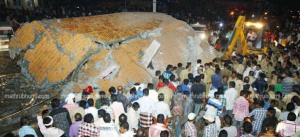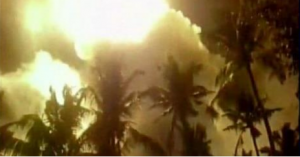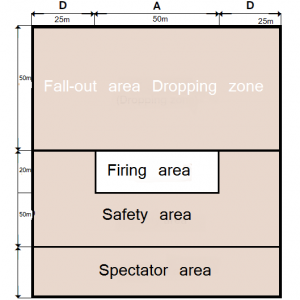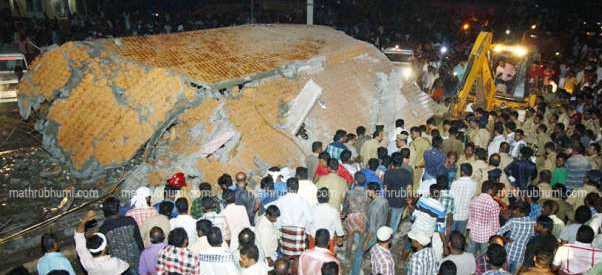
Tragedy strikes as 110 dead 350 injured in Quilon temple fireworks mishap
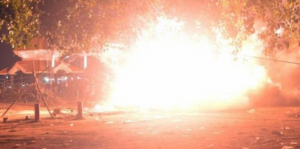
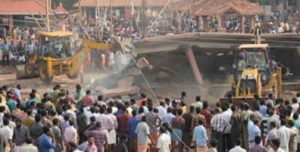
A huge explosion sparked by fireworks at the Puttingal Devi Hindu temple festival at Paravoor in Kerala South India around 3:30am local time ( 22:00 GMT Saturday 9th April 2016), witnessed by thousands of devotees, as sparks fell into the fireworks storeroom according to the local police.
An investigation has been ordered as officials claim permits for the fireworks display was refused earlier on safety grounds.
The chaos followed as emergency teams took time to reach the affected area as rescue teams have to source bulldozers to clear the area looking for survivors. A team of medical specialist were dispatched from Delhi to deal with the wounded as several injured were in critical condition in local hospitals.
Many were charred beyond recognition according to Kerala Police chief TP Senkumar. The intensity of the explosion was so high that there was a power outage in the complex after the first explosion hampering any rescue efforts. Houses in the near vicinity of the temple also have been badly damaged by the blast. One of the victims a biker was hit by flying concrete, 1km from explosion.
In January 2016, a firecracker manufacturing unit in Maradu, near Kottaram Bhagavathy temple, in Kochi caught fire killing a woman, causing devastating damage to properties in the surrounding areas. In March 2013, a firecracker unit in Panniyakurissy near Cheapalassery, killing seven people.
In February 2011, a fireworks unit near Shoranpur claiming 13 lives.
In December 2011, another explosion at Athani near Thissur killing six people.
In May 2006, Thissur Pooram festival witnessed an explosion killing four people.
In 1989 Kandashamkadavu church festival fireworks tragedy killing 12 people.
In 1988 Trippunithura ten people died when a shed housing crackers caught fire.
In 1984 Kandshamkadavu church festival killed 20 people after a firecracker blast.
In 1952, Sabrimala temple, 68 people dies from firecracker blast.
Clearly robust and detailed approach to planning was missing. Category 4 fireworks can only be used by professional firework disp0lay operators as in untrained hands can result in lethal tragedy. There should have been enough space for fireworks to land well away from spectators and there should be a firing zone and safe zone around it where people other than professional display operator should be allowed. Also to consideration needs to be given to direction of prevailing wind and hot ambient temperature. There was no emergency plan and the fireworks storage was not in a suitable place. Why did the temple ignore local authority directives. Not much thought have gone in planning how people will get into and out of the site and keeping pedestrian and vehicle routes apart. Appoint enough full trained stewards and marshals.Signpost the first aid facilities. There should have been a public liability insurance as it was a public fire display.
The authorities should consider the following so that such tragedies can be avoided, Firework displays, whether private or public, should be enjoyable occasions. If organisers take the necessary precautions, they should also be safe occasions.
Introduce regulations to primarily address the supply of fireworks and include provisions relating to the sale to the general public of a variety of types of fireworks such as:
- category 4 fireworks
- aerial shells and maroons
- shells-in-mortar and maroons-in-mortar
- bangers, including batteries containing bangers and Chinese crackers
- fireworks with erratic flight
- mini-rockets
- air bombs
- Introduce limits on the sizes of certain category 2 and 3 fireworks that can be supplied to the general public
- The control of the supply of certain types of excessively loud fireworks
- Limitation on the use of fireworks during night hours.
- To ensure that the site is free of dry, cut grass and other easily combustible materials.
- Essential checks for obstructions like trees, adjoining buildings and overhead electric power lines.
- Overhead electric power lines could also cause a flashover and these power lines could induce an electric current in wires, causing the premature firing of the fireworks.
- The spectator area – from which the spectators watch the display;
- The safety area – a clear area between the spectators and the firing area to ensure that spectators are at a safe distance from the fireworks during the display;
- The firing area – from which the fireworks are set off;
- The fall-out area (or dropping zone) – an area kept clear of people, where the debris from spent aerial fireworks lands; and
- The bonfire area – the area provided for the bonfire (if there is to be one).
- Site plan.
- Bonfire area must be at least 15m from other areas like buildings, railways, roads, public rights of way.
- Fireworks display must be a safe distance from inflammable materials like petrol, fuel oil, liquefied petroleum gas and overhead power lines.

